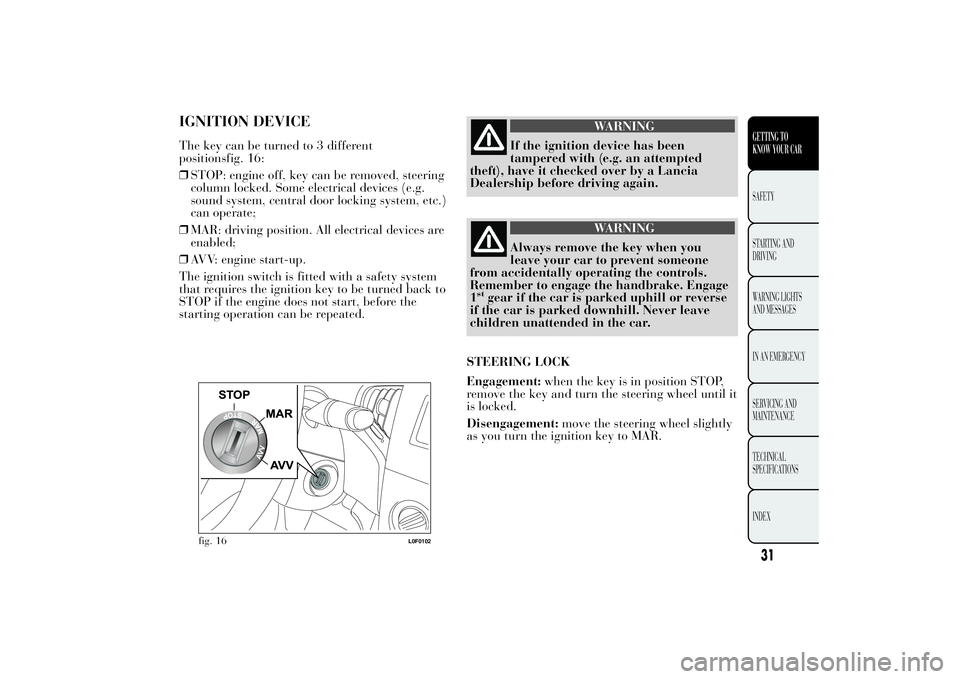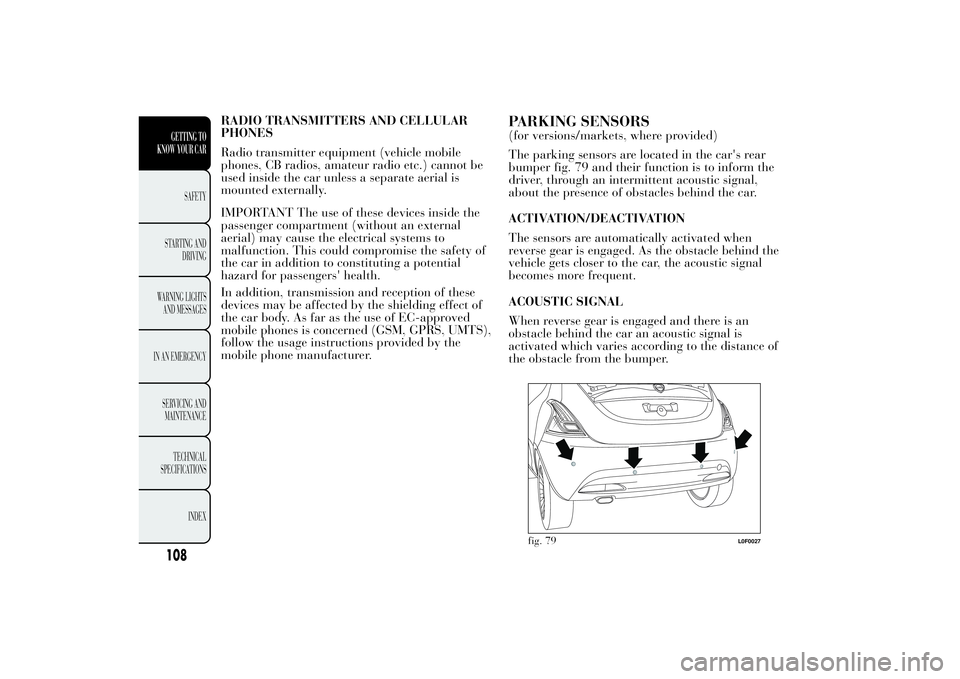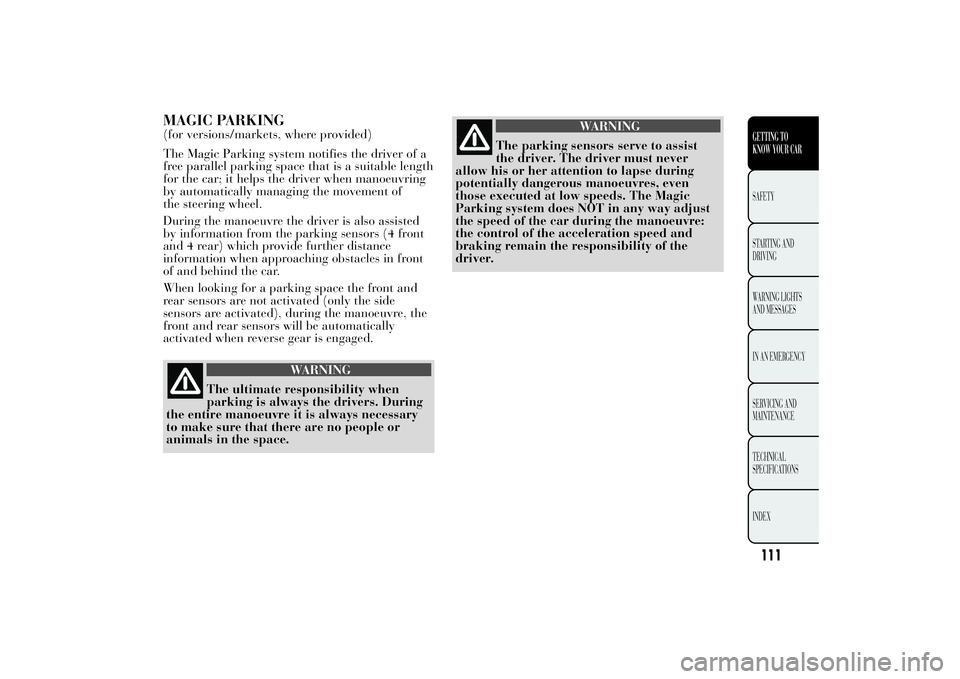Reverse gear Lancia Ypsilon 2013 Owner handbook (in English)
[x] Cancel search | Manufacturer: LANCIA, Model Year: 2013, Model line: Ypsilon, Model: Lancia Ypsilon 2013Pages: 315, PDF Size: 13.18 MB
Page 35 of 315

IGNITION DEVICEThe key can be turned to 3 different
positionsfig. 16:
❒STOP: engine off, key can be removed, steering
column locked. Some electrical devices (e.g.
sound system, central door locking system, etc.)
can operate;
❒MAR: driving position. All electrical devices are
enabled;
❒AVV: engine start-up.
The ignition switch is fitted with a safety system
that requires the ignition key to be turned back to
STOP if the engine does not start, before the
starting operation can be repeated.
WARNING
If the ignition device has been
tampered with (e.g. an attempted
theft), have it checked over by a Lancia
Dealership before driving again.
WARNING
Always remove the key when you
leave your car to prevent someone
from accidentally operating the controls.
Remember to engage the handbrake. Engage
1
stgear if the car is parked uphill or reverse
if the car is parked downhill. Never leave
children unattended in the car.
STEERING LOCK
Engagement:when the key is in position STOP,
remove the key and turn the steering wheel until it
is locked.
Disengagement:move the steering wheel slightly
as you turn the ignition key to MAR.
fig. 16
L0F0102
31GETTING TO
KNOW YOUR CARSAFETY
STARTING AND
DRIVING
WARNING LIGHTS
AND MESSAGES
IN AN EMERGENCY
SERVICING AND
MAINTENANCE
TECHNICAL
SPECIFICATIONS
INDEX
Page 62 of 315

WINDOW CLEANINGThe right stalk controls windscreen wiper/washer
and heated rear window wiper/washer operation.
WINDSCREEN WASHER/WIPER
They can be operated only with the ignition key
turned to MAR.
The ring nut A fig. 35 can be moved to four
different positions:
windscreen wiper off.intermittent operation.continuous slow operation.continuous fast operation.Move the stalk upwards (unstable position) to
limit operation to the time for which the stalk is
held in this position. When released, the stalk will
return to its default position and the wiper will
be automatically stopped.
With the ring nut A fig. 35 in position
, the
windscreen wiper will automatically adapt
operating speed to the speed of the car.
With the windscreen wipers operational, if reverse
gear is engaged, the rear window wiper is
automatically activated.
Never use the windscreen wipers to
remove layers of snow or ice from the
windscreen. In such conditions, the
windscreen wipers may be subjected to
excessive stress and the motor protection,
which prevents operation for a few seconds,
may intervene. If operation is not restored
(even after using the key to restart the engine),
contact a Lancia Dealership.Do not operate the windscreen wiper
with the blades lifted from the
windscreen.
fig. 35
L0F0126
58GETTING TO
KNOW YOUR CAR
SAFETY
STARTING AND
DRIVING
WARNING LIGHTS
AND MESSAGES
IN AN EMERGENCY
SERVICING AND
MAINTENANCE
TECHNICAL
SPECIFICATIONS
INDEX
Page 65 of 315

The rain sensor is able to recognise, and
automatically adjust itself in the presence of the
following conditions:
❒presence of dirt on the controlled surface (salt,
dirt, etc.);
❒presence of streaks of water caused by the worn
window wiper blades;
❒difference between day and night.
Do not activate the rain sensor when
washing the car in an automatic car
wash.Make sure the device is switched off if
there is ice on the windscreen.
WARNING
Make sure the device is switched off
whenever the windscreen must be
cleaned.REAR WINDOW WASHER/ WIPER
It can be operated only with the ignition key
turned to MAR.
Activation
Turn the ring nut B fig. 35 from
to
to operate
the rear window wiper as follows:
❒in intermittent mode when the windscreen wiper
is not operating;
❒in synchronous mode (at half the speed of the
windscreen wiper) when the windscreen wiper
is operating;
❒in continuous mode with reverse gear engaged
and the control active.
With the windscreen wiper on and reverse gear
engaged, rear window wiping will be continuous.
Pushing the stalk towards the dashboard
(unstable position) the rear window washer jet
will activate. Keep the stalk pushed for more than
half a second to activate the rear window wiper
as well. Releasing the stalk will activate the smart
washing function, as described for the windscreen
wiper.
61GETTING TO
KNOW YOUR CARSAFETY
STARTING AND
DRIVING
WARNING LIGHTS
AND MESSAGES
IN AN EMERGENCY
SERVICING AND
MAINTENANCE
TECHNICAL
SPECIFICATIONS
INDEX
Page 67 of 315

The speed adjustment function cannot be
activated in 1
stor reverse gear; it is advisable to
activate the function in 4
th
or higher gears.
When travelling downhill with the device active,
the car speed may slightly exceed the stored one.
Storing car speed
Proceed as follows:
❒turn ring nut A fig. 37 to ON and press the
accelerator pedal so that the car reaches the
desired speed;
❒move the stalk upwards (+) for at least one
second, then release it: the speed is memorised
and you can therefore release the accelerator
pedal.
If needed (when overtaking for instance), you can
accelerate simply by depressing the accelerator
pedal: when you release the pedal, the car goes
back to the speed stored previously.Restoring the stored speed
If the device has been deactivated, for example by
depressing the brake or clutch pedal, the stored
speed can be restored as follows:
❒accelerate progressively until a speed close to
that stored is reached;
❒engage the gear selected at the time that the
speed was stored;
❒press the RES button.
Increasing the stored speed
This can be carried out in two ways:
❒by pressing the accelerator and storing the new
speed reached
or
❒by moving the stalk upwards (+).
Each movement of the stalk corresponds to an
increase in speed of about 1 km/h, while keeping
the stalk held upwards will continuously increase
the speed.
63GETTING TO
KNOW YOUR CARSAFETY
STARTING AND
DRIVING
WARNING LIGHTS
AND MESSAGES
IN AN EMERGENCY
SERVICING AND
MAINTENANCE
TECHNICAL
SPECIFICATIONS
INDEX
Page 101 of 315

SYSTEM INTERVENTION
It is signalled by the flashing of theESCwarning
light on the instrument panel, to inform the driver
that the car is in critical stability and grip
conditions.
SYSTEM ACTIVATION
The ESC system switches on automatically when
the engine is started and cannot be switched off.
HILL HOLDER SYSTEM
This system is an integral part of the ESC system
and facilitates starting on slopes.
It is activated automatically in the following
instances:
❒uphill: car stationary on a road with a gradient
higher than 5%, engine running, brake pressed
and gearbox in neutral or gear (other than
reverse) engaged;
❒downhill: car stationary on a road with a
gradient higher than 5%, engine running, brake
pressed and reverse gear engaged.
When setting off, the ESC system control unit
maintains braking pressure on the wheels until the
torque required for starting is reach or, in any
case, for a maximum of 2 seconds so that the right
foot can be moved easily from the brake pedal to
the accelerator pedal.When 2 seconds have elapsed, without any
departure having taken place, the system is
automatically deactivated, gradually releasing the
braking pressure. During this release stage, a
typical mechanical brake release noise can
be heard, indicating that the car is about to move.
IMPORTANT The Hill Holder system is not a
parking brake, therefore do not leave the vehicle
without activating the handbrake, switching
off the engine and engaging first gear.
ASR SYSTEM (AntiSlip Regulation)
It is an integral part of the ESC system. It
automatically operates in the event of one or both
drive wheels slipping, loss of grip on wet roads
(aquaplaning) and acceleration on slippery, snowy
or icy roads, etc…
Depending on the slipping conditions, two
different control systems are activated:
❒if the slipping involves both drive wheels, the
ASR intervenes reducing the power transmitted
by the engine;
❒if the slipping only involves one of the drive
wheels, it intervenes automatically braking
the wheel that is slipping.
97GETTING TO
KNOW YOUR CARSAFETY
STARTING AND
DRIVING
WARNING LIGHTS
AND MESSAGES
IN AN EMERGENCY
SERVICING AND
MAINTENANCE
TECHNICAL
SPECIFICATIONS
INDEX
Page 104 of 315

MANUAL SYSTEM ACTIVATION/
DEACTIVATION
To activate/deactivate the system manually, press
the button
fig. 71 on the dashboard control
trim.
Start&Stop system activation
Start&Stop system activation is signalled by a
message on the display. In this condition, the LED
on the button
is off.
Start&Stop system deactivation
Versions with multifunction display: a message
appears on the display when the Start&Stop
system is deactivated.
Versions with reconfigurable multifunction
display: thesymbol and a message appear on
the display when the Start&Stop system is
deactivated.The LED above the
button is on when the
system is deactivated.
ENGINE STOPPING FAILURE CONDITIONS
When the system is active, due to comfort,
emission control and safety reasons, the engine
does not stop in some conditions, among which:
❒engine still cold;
❒especially cold outside temperature;
❒battery not sufficiently charged;
❒particulate filter regeneration (DPF) in progress
(diesel engines only);
❒driver's door not shut;
❒driver's seat belt not fastened;
❒reverse gear engaged (for example, for parking
manoeuvres);
❒for versions equipped with automatic climate
control (for versions/markets, where provided),
if an adequate level of thermal comfort has
not been reached or with MAX-DEF activation;
❒during the first period of use, to initialise the
system.
If climate comfort is to be favoured, the
Start&Stop system can be disabled,
for a continuous operation of the
climate control system.
fig. 71
L0F0044
100GETTING TO
KNOW YOUR CAR
SAFETY
STARTING AND
DRIVING
WARNING LIGHTS
AND MESSAGES
IN AN EMERGENCY
SERVICING AND
MAINTENANCE
TECHNICAL
SPECIFICATIONS
INDEX
Page 112 of 315

RADIO TRANSMITTERS AND CELLULAR
PHONES
Radio transmitter equipment (vehicle mobile
phones, CB radios, amateur radio etc.) cannot be
used inside the car unless a separate aerial is
mounted externally.
IMPORTANT The use of these devices inside the
passenger compartment (without an external
aerial) may cause the electrical systems to
malfunction. This could compromise the safety of
the car in addition to constituting a potential
hazard for passengers' health.
In addition, transmission and reception of these
devices may be affected by the shielding effect of
the car body. As far as the use of EC-approved
mobile phones is concerned (GSM, GPRS, UMTS),
follow the usage instructions provided by the
mobile phone manufacturer.
PARKING SENSORS(for versions/markets, where provided)
The parking sensors are located in the car's rear
bumper fig. 79 and their function is to inform the
driver, through an intermittent acoustic signal,
about the presence of obstacles behind the car.
ACTIVATION/DEACTIVATION
The sensors are automatically activated when
reverse gear is engaged. As the obstacle behind the
vehicle gets closer to the car, the acoustic signal
becomes more frequent.
ACOUSTIC SIGNAL
When reverse gear is engaged and there is an
obstacle behind the car an acoustic signal is
activated which varies according to the distance of
the obstacle from the bumper.
LANCIA
fig. 79
L0F0027
108GETTING TO
KNOW YOUR CAR
SAFETY
STARTING AND
DRIVING
WARNING LIGHTS
AND MESSAGES
IN AN EMERGENCY
SERVICING AND
MAINTENANCE
TECHNICAL
SPECIFICATIONS
INDEX
Page 115 of 315

WARNING
The parking sensors serve to assist
the driver. The driver must never
allow his or her attention to lapse during
potentially dangerous manoeuvres, even
those executed at low speeds. The Magic
Parking system does NOT in any way adjust
the speed of the car during the manoeuvre:
the control of the acceleration speed and
braking remain the responsibility of the
driver.
111GETTING TO
KNOW YOUR CARSAFETY
STARTING AND
DRIVING
WARNING LIGHTS
AND MESSAGES
IN AN EMERGENCY
SERVICING AND
MAINTENANCE
TECHNICAL
SPECIFICATIONS
INDEX
MAGIC PARKING(for versions/markets, where provided)
The Magic Parking system notifies the driver of a
free parallel parking space that is a suitable length
for the car; it helps the driver when manoeuvring
by automatically managing the movement of
the steering wheel.
During the manoeuvre the driver is also assisted
by information from the parking sensors (4 front
and 4 rear) which provide further distance
information when approaching obstacles in front
of and behind the car.
When looking for a parking space the front and
rear sensors are not activated (only the side
sensors are activated), during the manoeuvre, the
front and rear sensors will be automatically
activated when reverse gear is engaged.
WARNING
The ultimate responsibility when
parking is always the drivers. During
the entire manoeuvre it is always necessary
to make sure that there are no people or
animals in the space.
Page 117 of 315

IMPORTANT The SEARCHING is disabled if,
after about 10 minutes, a suitable parking space
has not been found.
❒Identification:if the system identifies a free
parking space that is a suitable size for the
car, it signals its presence and indicates
the actions required for starting the manoeuvre.
❒Manoeuvre:the driver is asked to engage
reverse gear, release the steering wheel and
manage the accelerator, brake and clutch (in the
case of manual gearbox) or accelerator and
brake (in the case of automatic gearbox) (for
versions/markets, where provided). During the
reverse parking manoeuvre, the system manages
the steering wheel automatically. According to
the parking space, the manoeuvre may end
through reversing or further manoeuvres may be
necessary in both in forward and reverse gears.
After the first manoeuvre, when the rear buzzer
sounds continuously, the driver is requested to
disengage reverse and engage the forward
gear. If this is not enough, when the continuous
tone is reached, the driver is requested to engage
reverse. The semi-automatic manoeuvre ends
when the display shows the message "End
manually".
❒Conclusion:at the end of the manoeuvre, the
driver resumes control and, if necessary, has to
complete parking manually.
IMPORTANT MANOEUVRING is disabled if,
after 3 minutes, parking has not been completed.IMPORTANT Steering will be realigned after
reversing when reverse gear is disengaged. The
driver must complete the manoeuvre manually.
The Magic Parking operation is based
on various components: front and
rear parking sensors, side sensors,
steering system, wheels and braking system,
instrument panel. Bear in mind that
malfunction of one of these components could
compromise the operation of the system.
DESCRIPTION OF MANOEUVRING STAGES
Activation
The system is activated by pressing button
:as
soon as it is activated, the system starts searching
(the switching on of the LED on the button
indicates that the system is active).
Since the system recognises parking spaces even
when it is deactivated, the system can be activated
straight away after having driven past an
adjacent parking space that is deemed suitable.
If the system has identified a parking space,
searching will not be performed and the system
will notify the driver of the operations required to
carry out the manoeuvre correctly through the
instrument panel display.
113GETTING TO
KNOW YOUR CARSAFETY
STARTING AND
DRIVING
WARNING LIGHTS
AND MESSAGES
IN AN EMERGENCY
SERVICING AND
MAINTENANCE
TECHNICAL
SPECIFICATIONS
INDEX
Page 119 of 315

IMPORTANT If the "Lane Change" function is
activated (see paragraph "Exterior lights" in this
chapter), the search for the parking space always
takes place on the passenger side.
IMPORTANT If the parking sensors are activated
during the search for a parking space (see
paragraph "Front and rear parking sensors" in
this chapter), the system is deactivated.
WARNING
The search for the parking space and
the parking manoeuvres must be
performed in compliance with the current
regulations of the Highway Code.
Identifying a parking space
If the system identifies a suitable parking space
between two stationary vehicles or between other
obstacles (e.g. objects with an extensive side
surface such as vehicles, boxes, etc.) it will signal
that it has found a parking space that can be
entered fig. 83.
If the position reached is already suitable at the
beginning of the manoeuvre, the system will
advise the driver to engage reverse gear, otherwise
it will request further forward motion.At the request to engage reverse gear the driver
should stop the car and engage reverse in order to
confirm the wish to start the manoeuvre. If the
driver continues driving, after about 10 metres the
system will no longer consider the parking space
identified and will start the search for new
suitable space.
Manoeuvre
The driver controls the movements of the car
using accelerator pedal, brake and clutch (only on
versions with manual gearbox) whilst the system
automatically manages the steering system to
enter the parking space identified in the best
possible way.
During the manoeuvre it will be possible to take
advantage of the information coming from the
parking sensors (when reversing it is advisable to
reach the area where the rear sensors provide a
continuous tone signal), but it is always advisable
to keep an eye on the surrounding area.
fig. 83
L0F1002
115GETTING TO
KNOW YOUR CARSAFETY
STARTING AND
DRIVING
WARNING LIGHTS
AND MESSAGES
IN AN EMERGENCY
SERVICING AND
MAINTENANCE
TECHNICAL
SPECIFICATIONS
INDEX